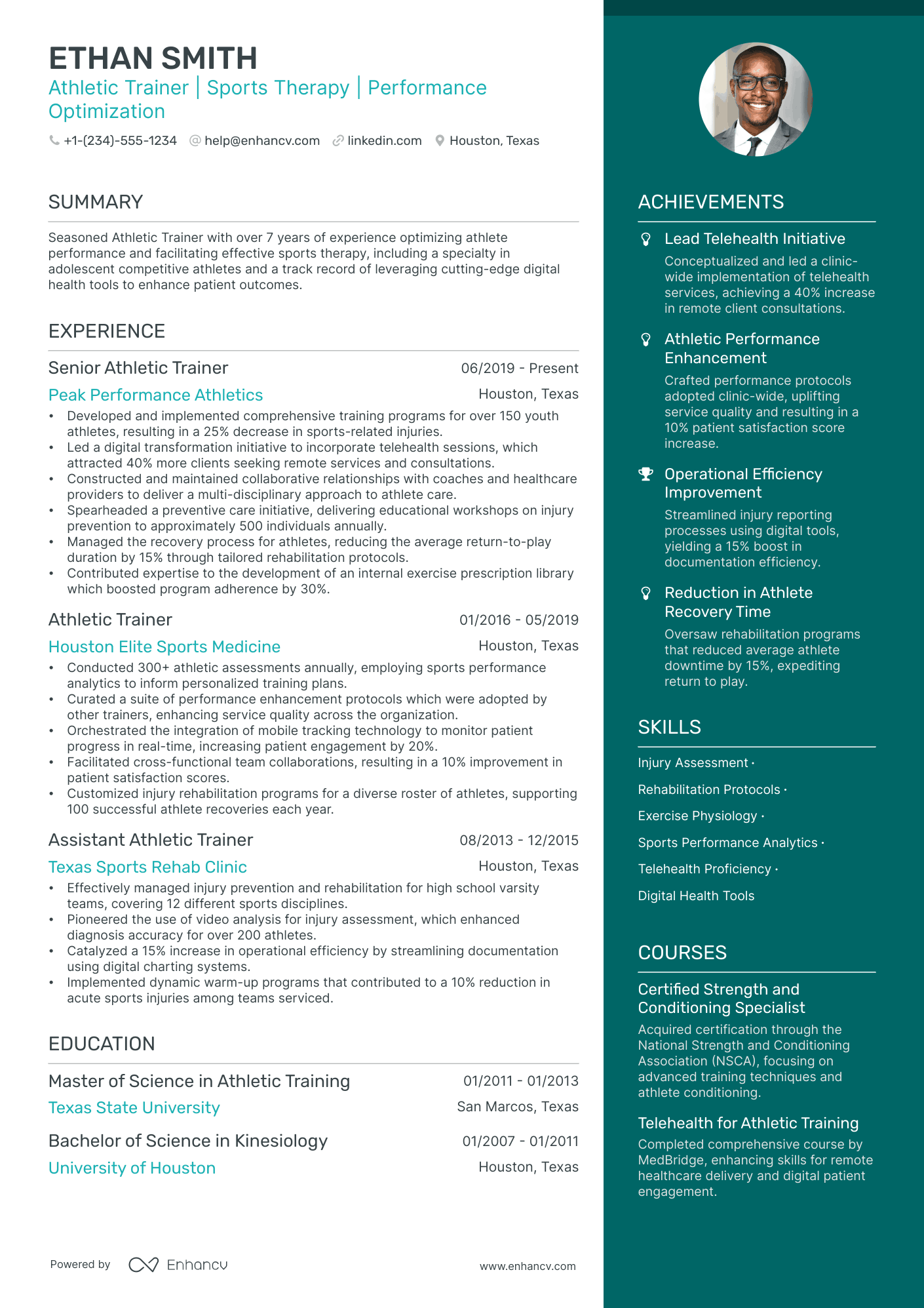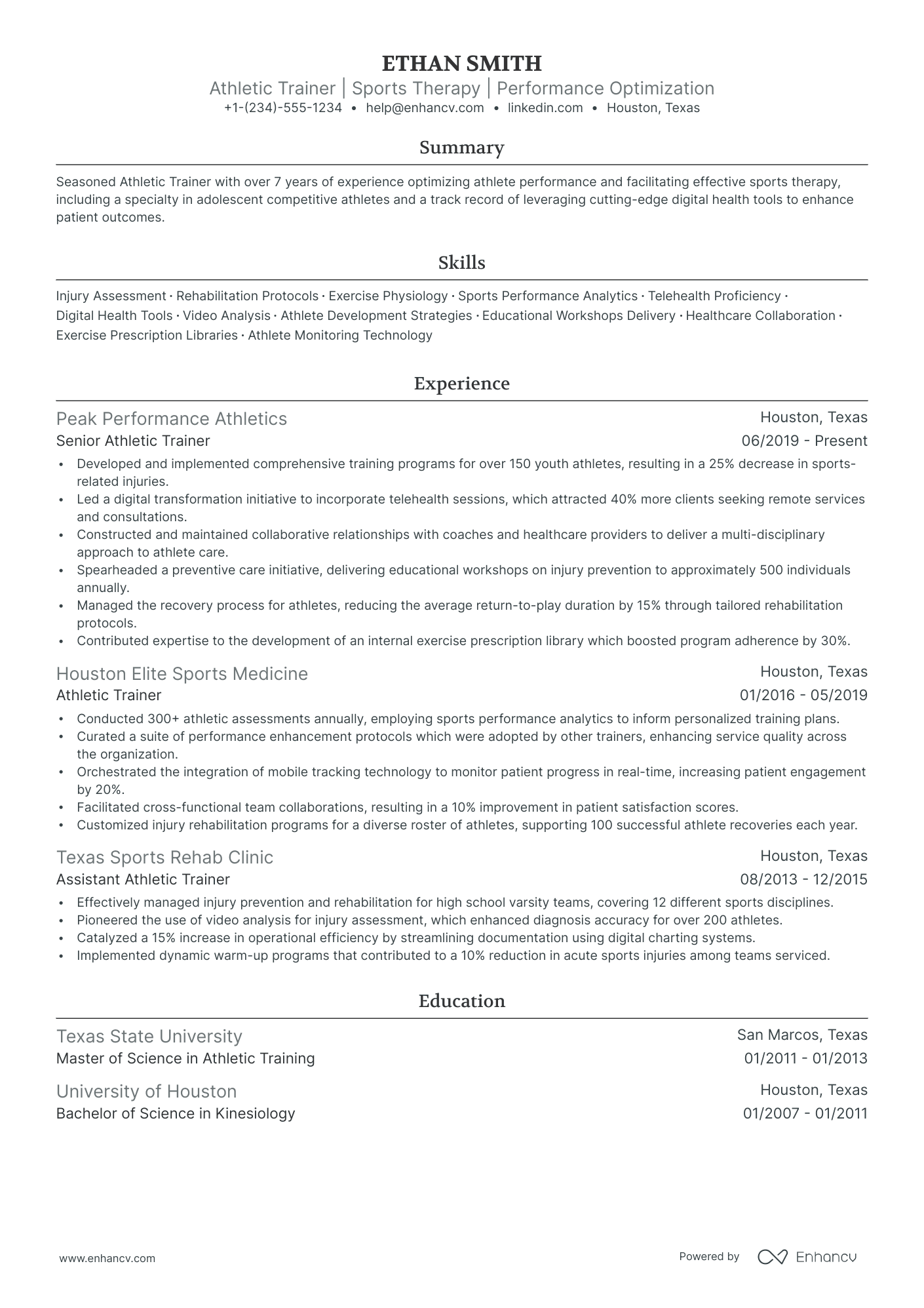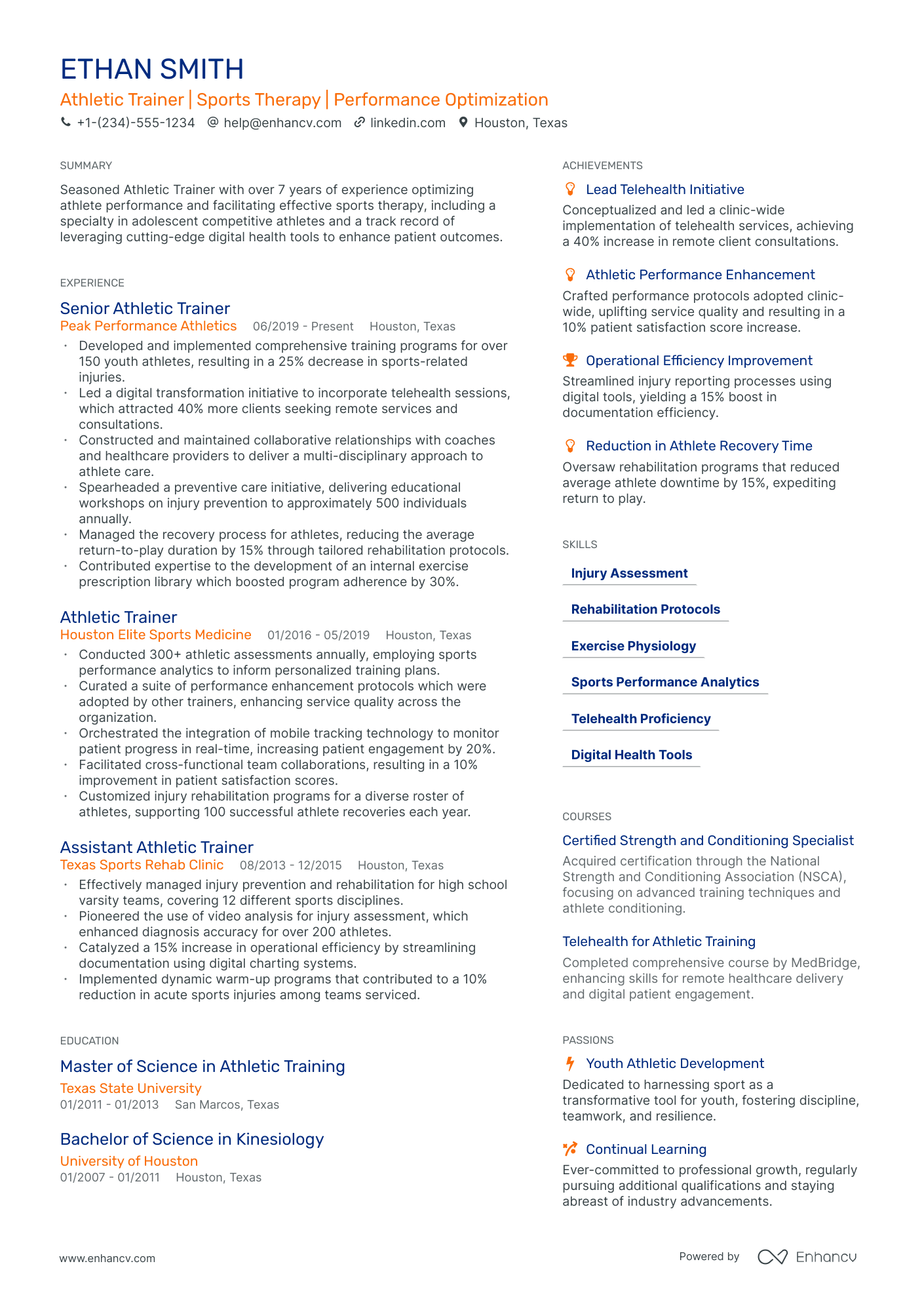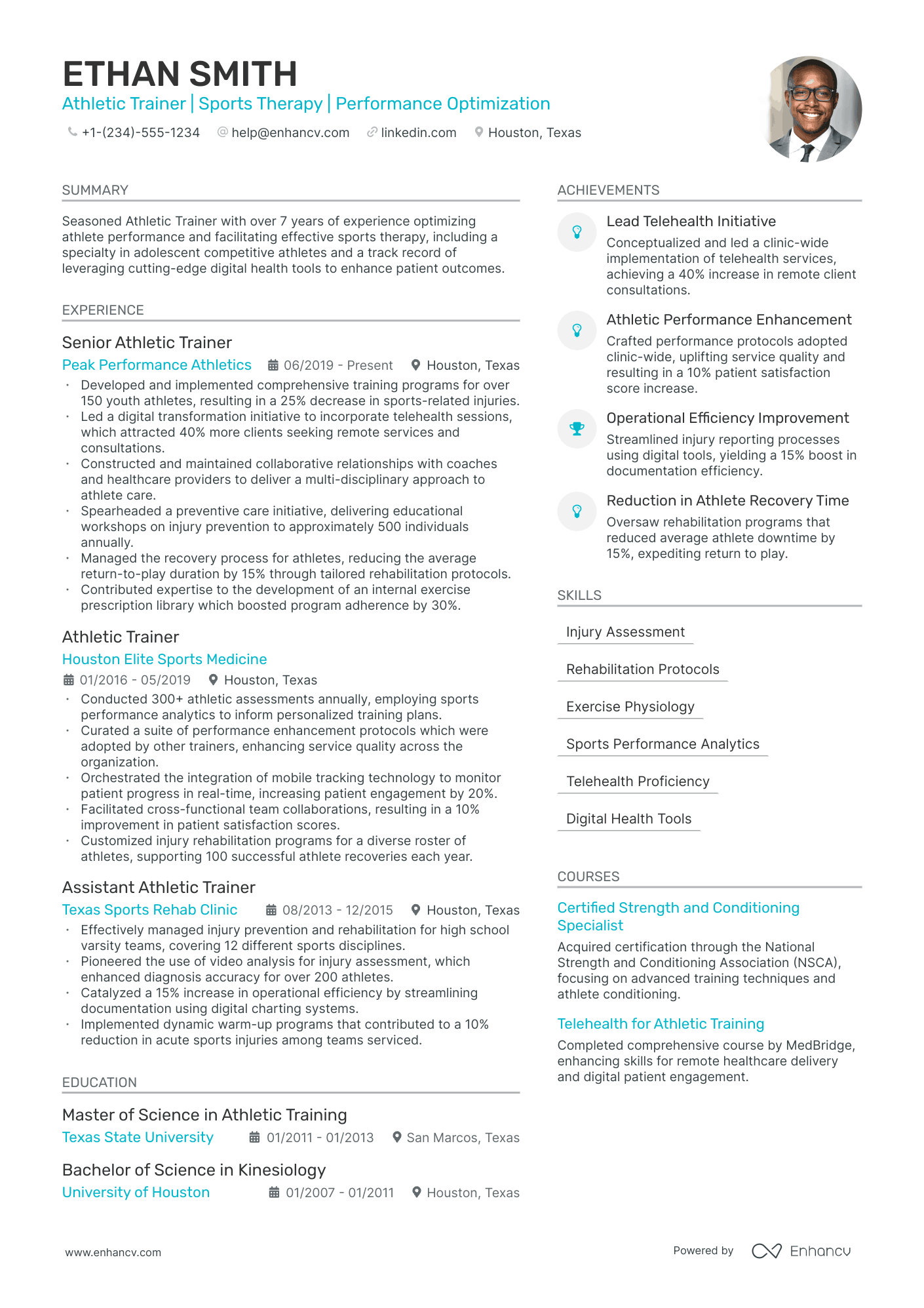According to a survey conducted by the Kaiser Family Foundation and CNN 90% of the public think there is a mental health crisis in the United States today. Moreover, half of young adults and one-third of all adults report feeling anxious either always or often in the past year.
As a therapist, you understand that no magic words can instantly make clients feel better. Sometimes, even after the therapy session ends, the emotional burden of your clients may still linger with you, weighing on your mind when you finally rest at night. However, the transformation of your clients, though it may be slow, is gratifying and truly inspiring. For better or worse, these challenging times bring plenty of job opportunities for therapists.
And if you're unsure about how to create a compelling therapist resume, don't worry. We'll help you.
Discover how to:
- Select a resume template that showcases your expertise in therapeutic techniques and approaches.
- Organize your resume's main sections to underscore your experience and qualifications.
- Emphasize your proficiency in various therapeutic practices and essential counseling software.
- Describe your key achievements and their impact on client well-being and progress.
- Align your skills with the job description to demonstrate your suitability for the role.
- List your relevant educational qualifications, focusing on degrees and licenses in therapy and counseling.
Want to broaden your horizons in healthcare and well-being? Look at these resume examples to find new roles in therapy and counseling.
- Home Health Aide Resume Example
- Mental Health Coach Resume Example
- Health Coach Resume Example
- Life Coach Resume Example
- Massage therapist Resume Example
- Psychologist Resume Example
- Psychiatrist Resume Example
- Occupational therapist Resume Example
- School Counselor Resume Example
- Therapist Cover Letter Example
How to format a therapist resume
Depending on your situation, you can choose from three resume formats:
- Reverse chronological resume: Ideal for therapists with a steady work history, this format lists your jobs starting with the most recent. It's perfect for demonstrating a consistent career path and professional growth, which appeals to employers looking for experienced candidates.
- Functional resume: If you're new to the field, changing careers, or have gaps in your work history, a skills-based resume might be best. This format emphasizes your skills and qualifications over job history, allowing you to highlight your therapeutic abilities and certifications without focusing on employment gaps.
- Combination resume: This combination format is excellent for therapists with both solid experience and relevant skills. It enables you to showcase your skills and work history together. This flexible approach underlines your abilities and career progression, making it suitable for various therapy roles, from entry-level to senior positions.
Want a resume that grabs recruiters' attention? Use these practical tips to organize it effectively for a therapist position.
- Choose a double-column template to make your resume visually appealing and easy to read.
- Use resume fonts like Rubik, Lato, or Times New Roman in sizes 10 to 12 for a clean, professional look.
- Set your margins to a maximum of 1 inch and pick a resume design with smart color to direct the hiring manager's attention to the important resume elements. A clean design adds a personal touch and keeps the reader engaged.
- Include your name, phone number, location, and professional email address in the header of your resume. Also, add your LinkedIn profile if it’s updated and relevant.
- If you're early in your career as a therapist, keep your resume to one page. For those with more than 10+ years of experience, a two-page resume is acceptable.
- Check the job description to see if a resume photo is needed. In the US, it's generally advised against including a photo, but since your role involves significant face-to-face interaction, a photo might still be required.
- Save your resume as a PDF file to maintain its format on any device.
Take advantage of our ATS resume checker for a complimentary, detailed 16-point assessment to boost your resume's competitive edge.
Is your resume good enough?
Drop your resume here or choose a file. PDF & DOCX only. Max 2MB file size.
After choosing the format, we'll create a therapist resume that stands out. We'll review key sections such as:
The top sections on a therapist resume
- Professional summary: Include this to provide a brief introduction of your professional background and strengths as a therapist.
- Licenses and certifications: This specifies your legal and professional qualifications, proving your competency as a therapist.
- Specific therapy skills: Detail your unique skill set in this section which showcases your ability to provide therapy services effectively.
- Work experience: This section demonstrates your practical application of therapy skills and methods in a professional setting.
- Education and training: It’s important to include your academic background and additional professional training as they justify your knowledge in the field of psychotherapy.
Let's see what recruiters look for in each section of your therapist resume and how they evaluate them.
What recruiters want to see on your resume:
- Relevant qualifications: Hiring managers prioritize candidates with necessary qualifications as they signify the therapist's understanding and knowledge in the field.
- Hands-on experience: Recruiters give preference to therapists with practical experience, as it affirms your ability to apply learned therapy techniques.
- Certification details: Displaying accredited certifications assures the recruiters of your commitment to professional standards in therapy.
- Client handling skills: The therapist's job heavily involves interacting with the clients, so recruiters pay attention to your interpersonal and communication skills.
- Therapeutic approaches: Understanding your expertise in various therapy methodologies confirms your ability to handle a diverse range of client needs and issues.
Therapists guide individuals through the process of healing by helping them find meaning in their suffering.
Dr. Viktor Frankl
Whatever resume format you choose, the experience section is essential. We'll guide you in tailoring it for a therapist role.
How to write your therapist resume experience
The experience section of your resume tells your professional journey as a therapist. To make it interesting, keep these pointers in mind:
- Focus on therapy-related roles, listing the organization, a brief overview, and dates, followed by up to six bullet points for each position.
- Emphasize tangible outcomes from your work, using numbers or percentages to show your impact.
- Choose impactful action verbs to describe your tasks in a clear and engaging manner.
- Highlight your most significant and relevant accomplishments within each role.
51% of applicants don't use buzzwords, clichés, and pronouns correctly in their resumes.
Using buzzwords wisely can help you secure an interview by showcasing key skills, but overuse can deter hiring managers. Instead of vague terms like "empathetic" or "good listener," demonstrate your abilities with specific examples from your experience as a therapist.
Follow the tips above to create a targeted resume experience section.
Now, let's delve into a therapist job description to tailor your experience entries appropriately.
Job title
Mental Health Therapist
Full job description
We are seeking a Licensed Mental Health Therapist to work in our outpatient therapy clinic. The ideal candidate will possess a trauma and family-oriented approach and will have experience with children/ adolescents and experience or willingness to work with families of children with special healthcare needs.
What you’ll do:
- Provide comprehensive mental health assessment, diagnosis, and treatment services for pediatric clients and their families.
- Focus on family partnership and the social and emotional needs of the child to help them experience hope and build resiliency in their lives.
- Provide complete, thorough, ongoing assessment of children and families via guidelines, including psychosocial and treatment needs.
- Develop focused treatment plans that identify specific, measurable objectives, performance goals, and interventions.
Required:
- Current Licensed Independent Social Worker, Licensed Mental Health Counselor, Licensed Marital and Family Therapist, or Licensed Psychologist
- Strong verbal and written communication skills
- Demonstrated a high level of ethics.
- Flexibility and adaptability within an evolving service and processes
- Experience with children & adolescents preferred.
- Play Therapy, EMDR, PCIT training or willingness to get trained.
- Ability to read, write, and speak the English language.
- Ability to lift up to 35 lbs, be mobile within the assigned work area, and frequently bend, lift, reach, and stand.
Take a moment to review this badly crafted experience entry.
- •Provided therapy to clients.
- •Developed and implemented treatment plans.
- •Conducted assessments and diagnostic evaluations.
- •Keep records and documentation.
A plain list of duties doesn't make any applicant stand out. Here's why this clinical therapist's resume entry doesn't meet expectations:
- Too vague: The entry "provided therapy to clients" is too broad. It doesn't showcase specialized therapeutic skills or specific experience relevant to therapy roles.
- Not enough detail: It mentions developing treatment plans but doesn't specify the therapeutic approaches or methods used, such as CBT, DBT, or family therapy. This lack of detail means it doesn't align with job requirements.
- Lacks quantifiability: The entry doesn't provide measurable outcomes, such as the number of clients treated, improvement percentages, or specific success stories, which are crucial for demonstrating effectiveness and impact.
Overall, the entry doesn't present a strong case for the candidate. The next person, however, goes above and beyond by being way more specific.
Let’s see.
- •Assessed, diagnosed, and treated over 100 children and families, improving mental health outcomes by 40%.
- •Created and implemented treatment plans with clear goals and steps for 100+ clients over a 12-month period.s.
- •Conducted regular evaluations for the needs of 150 children and their families.
- •Maintained detailed records and documentation for all clients, ensuring 100% compliance with guidelines.
Here’s why this entry catches the attention of recruiters:
- Quantifiable achievements: This candidate demonstrates significant results with real numbers - “over 100 children and families, resulting in a 40% improvement”.
- Relevant experience: The resume shows how the candidate created and implemented treatment plans with clear goals and steps for 100+ clients over a 12-month period.
- Impactful results: Maintained detailed records and documentation for all clients, ensuring 100% compliance with guidelines. This approach shows how well the applicant worked and the difference it made, which is sure to impress the recruiters.
This resume demonstrates how the candidate's experience meets the job requirements in a professional way.
How to quantify impact on your resume
As you already see, quantifying your achievements can show how your interventions have enhanced patient well-being. This method emphasizes your true impact, like boosting treatment success rates or reducing anxiety levels.
Consider these examples to prove your achievements in your past therapy positions.
- Number of patients handled: Listing this can display your ability to manage caseloads, offering insights into your professional capacity and time management skills.
- Success rate in treatment plans implementation: Featuring this can demonstrate your effectiveness as a therapist, emphasizing your competence in delivering desired outcomes.
- Percentage of patients showing improvement: This indicates the level of success in your therapy methods, reflecting your direct contribution to the well-being of clients.
- Number of specific therapy methods mastered: Mentioning this showcases your competency and versatility in offering diverse therapeutic approaches.
- Increase in client retention rate: Detailing this proves your ability to build and maintain professional relationships, which is crucial for a therapist.
- Number of professional training courses completed: Citing this number shows your commitment to continuous learning, necessary for staying updated in the therapy field.
- Quantitative client satisfaction scores: Including this offers a clear indication of your effectiveness from the client's perspective, demonstrating your ability to meet their needs.
- Number of cases handled involving specific conditions: This indicates your specialization or expertise in managing particular conditions or disorders, which could make you an ideal fit for certain roles.
How do I write a therapist resume with no experience
No need to worry. There's a template that fits. Use a functional resume layout to focus on your skills and educational background. This format is great for detailing any supervised sessions or volunteer experiences.
Once you have the format figured out, think about the best way to present your information. Underscore your job-relevant skills to make them stand out to potential employers.
If you're applying for a therapist position, consider these tips:
- Objective statement: Write a concise statement that shows your passion for therapy, highlights your relevant experience, and sets out your career goals. Keep it to 3 sentences.
- Education: List your education in psychology, counseling, or similar fields. Focus on courses relevant to therapy, like clinical psychology or mental health studies.
- Internships: Mention any therapy-related internships you’ve done, whether they were paid or unpaid.
- Volunteer work: Bring attention to your hands-on clinical roles, such as volunteering. Also, include details about any opportunities where you have supervised or tracked the work of others.
- References: Provide references from teachers or mentors if you have them, or note that they’re available upon request.
- Research activities: Outline any research activities you’ve engaged in. Describe your contribution, the study's goals, and any outcomes or presentations. For instance: "Took part in a research examining the effectiveness of cognitive-behavioral therapy in treating social anxiety disorder, presented at the 26th International Seminar in New York City in 2024."
These steps will prove your initiative and skills, which are essential for a career in therapy.
STATISTICS ABOUT ANXIETY
Anxiety disorders are the most common mental health issue in the United States, affecting 40 million adults over the age of 18, or roughly 19% of adults. Every year, about 20% of working adults experience a mental health issue, such as depression or anxiety—the two most common reasons why people go to therapy.
How to list your counseling/therapy skills on your resume
Showing your skills on your resume is essential as it highlights your qualifications and strengths. This helps employers quickly assess your fit for a therapist role and aligns your abilities with the job's needs. It also increases your resume's visibility in Applicant Tracking Systems and underscores your value to potential employers.
Let’s focus on hard skills for therapy.
Hard skills
Detailing your hard skills on a therapist's resume is crucial as it demonstrates your expertise in therapeutic methods and practices required for the job. Create a specific section labeled "Hard skills," ideally positioned near the top or right after your work experience. List and prioritize skills such as therapeutic techniques, tools, and methodologies you excel in.
Customize these skills to match the position you’re seeking. If you have a broad range of key skills, consider categorizing them under headings like "Therapeutic techniques," "Client evaluation," "Crisis intervention", etc. Thus, you’ll achieve clearer presentation.
Best hard skills for your therapist resume
- Cognitive-behavioral therapy
- Dialectical behavior therapy
- EMDR techniques
- Grief counseling
- Substance abuse counseling
- Family therapy
- Trauma-focused therapy
- Child and adolescent psychology
- Knowledge of DSM-5
- Psychoanalysis
- Proficiency in digital counseling platforms
- Application of therapeutic tools and software
- Use of biofeedback techniques
- Hypnotherapy
- Art therapy
- Play therapy
- Data analysis in behavioral health
- Skills in digital note-taking and record maintenance
- Expertise in psychometric testing
- Competency in telehealth software
Soft skills are important for your therapy resume because they underline your ability to connect with clients and handle diverse situations. In contrast to hard skills, don't include people skills in a separate section, but rather weave them throughout your resume.
Soft skills
The first place to mention soft skills and specific examples of using them is in your summary or objective.
Besides, you can integrate relevant soft skills within your work experience and education sections to show your empathetic behavior. It's strongly advised to include relevant keywords from the job listing to show your understanding of the role.
Below are some suggestions suitable for the therapy field:
Best soft skills for your therapist resume
- Listening skills
- Empathy
- Patience
- Confidentiality
- Open-mindedness
- Sensitivity
- Time management
- Stress management
- Assertiveness
- Cultural competence
- Resilience
- Self-awareness
- Professional boundaries
- Interpersonal skills
- Collaboration skills
- Adaptability
- Problem-solving
- Work ethics
- Communication
Moving in, let’s focus on another important section of your application—your education.
How to list your education and certifications on your resume
Being a therapist requires a license. To become a licensed therapist, you need at least a master’s degree, which typically takes two to three years to complete. Some pursue a doctorate, but all licensed therapists must have a minimum of two to three years of postgraduate education. Practicing independently with just a bachelor’s degree isn’t allowed.
There are various types of therapists and therapy licenses.
The most common types of licensed therapists are:
- Licensed professional counselors (LPCs)
- Licensed mental health counselors (LMHCs)
- Licensed marriage and family therapists (LMFTs)
- Licensed clinical social workers (LCSWs)
- Psychologists (PhDs or PsyDs)
- Psychiatrists (MDs or DOs)
Make sure to list all your academic degrees to strengthen your candidacy for the role you're pursuing.
Follow these steps to set up an impressive education section on your therapist’s resume:
- Degree title: List the degree you earned relevant to therapy, such as a Master's in Counseling or Clinical Psychology.
- School name: Provide the name of the educational institution you attended.
- Graduation year: Indicate the year you graduated or expect to graduate.
- Major: Highlight your field of study, such as counseling, psychology, or social work, which are pertinent to therapy roles.
- Relevant certifications: Include any therapy-specific certifications you hold, such as Licensed Professional Counselor (LPC) or Licensed Clinical Social Worker (LCSW).
- Additional training: Mention any additional courses or workshops you completed that enhance your therapeutic expertise, such as cognitive-behavioral therapy or trauma-informed care.
- GPA: If your Grade Point Average is above 3.5, consider adding it to emphasize your academic excellence.
Try this simple format for structuring this part of your resume.
- •Specialized in cognitive-behavioral therapy and trauma-informed care.
- •Completed a thesis on the effectiveness of mindfulness-based therapy in reducing anxiety.
- •Focused on psychological theories and mental health disorders.
- •Completed a capstone project on the impact of social media on adolescent mental health.
Before legally practicing as a therapist, you must earn a master's degree and meet licensure requirements. Certification involves completing 2,000 to 4,000 hours of supervised clinical experience, often gained through an internship program. You can pursue internships during your master’s studies, allowing you to accumulate hours and speed up the licensure process.
Requirements for becoming a licensed therapist vary by state. You may consult the National Board for Certified Counselors to find specific guidelines for your state.
Adding your therapy certifications to your resume proves your qualifications. Here’s a list of the top certifications in the field:
Best certifications for your therapist resume
Having finished that, let's turn to writing an engaging resume summary and objective statements for therapy job applications.
How to write your therapist resume summary or objective
When applying for a therapist position, a compelling summary or objective can make your resume stand out. Both are essential for quickly catching the recruiter's attention and demonstrating your fit for the role.
Here's the difference:
- Summary: Provide a brief overview of your top professional achievements and relevant skills in 3 to 5 sentences. This is ideal if you have significant experience in therapy.
- Objective statement: Keep it concise, around 3 sentences, focusing on your career goals and why you're interested in this role. This is effective if you're new to therapy, changing careers, or re-entering the workforce.
Want some inspiration? Here’s an example of a resume summary to guide you.
PRO TIP
Create a resume summary or objective that doesn't include a first-person narrative as it can be perceived as a bit arrogant.
Next, let's provide an example of an objective statement.
Here are some tips for crafting an effective resume summary or objective for a therapist role:
- Customize it: Adapt your summary or objective to align with the specific therapist position and the organization’s environment you’re applying to. Demonstrate how your skills and approach fulfill their requirements.
- Use real numbers: Enhance your credibility by including quantifiable achievements. For instance, "Increased mental health outcomes for over 100 clients by 40% through tailored treatment plans."
- Highlight therapy skills: Emphasize key therapy skills such as expertise in cognitive-behavioral therapy, trauma-informed care, and strong communication skills to connect with clients.
- Stress relevant experience: Note any particular experience you have in different therapeutic settings, along with any pertinent certifications like Licensed Professional Counselor (LPC) or Licensed Clinical Social Worker (LCSW).
Investing effort into a specific and tailored summary or objective can significantly enhance your resume’s impact.
Additional sections for a therapist resume
We recommend you to include one or two additional sections but they should align with the job description. For therapy roles, adding specific details can help you get noticed.
- Passions: Share your hobbies and interests, such as swimming, yoga, or traveling, to show a well-rounded personality.
- Language skills: Mention any additional languages you speak to demonstrate your ability to work with a diverse client base. Spanish is the most common second language among U.S. Therapists, making it especially valuable.
- Awards: Underline any awarded achievements, such as recognition for clinical excellence or contributions to mental health initiatives, to emphasize your proficiency and dedication in the field.
- Tutoring work: Include any tutoring or mentoring experience, which shows your ability to educate and guide others, enhancing your therapeutic skills.
Key takeaways
Now that you have the essentials, let's summarize the key points for your therapist resume:
- Choose the right resume format—reverse chronological for steady work history, functional for career changes or gaps, and combination for a mix of experience and skills.
- Customize your summary or objective to reflect the specific therapist position and the organization’s environment. Show how your skills and approach align with their needs.
- Emphasize essential therapy skills like cognitive-behavioral therapy (CBT), trauma-informed care, and strong communication abilities.
- List all academic degrees and relevant certifications, focusing on those pertinent to therapy roles to strengthen your candidacy.
- Use relevant keywords from the job listing to increase your resume's visibility in Applicant Tracking Systems.
- Craft a compelling summary if you have significant experience, or an objective if you’re new to the field or changing careers.
- Add a few additional sections to demonstrate a well-rounded personality and more qualifications.




